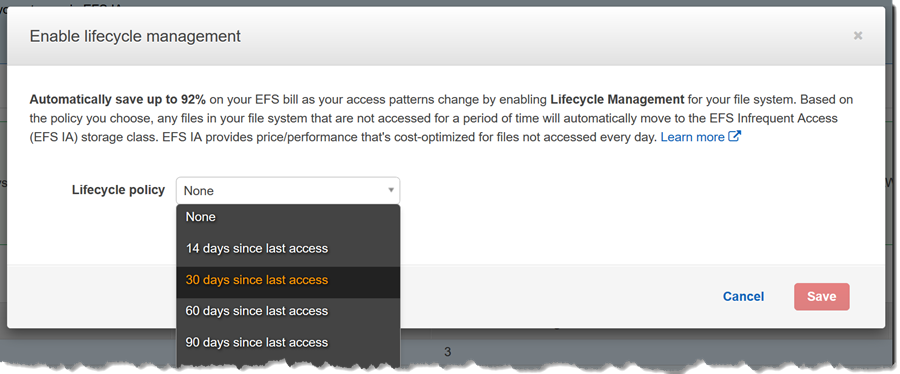AWS News Blog
Optimize Storage Cost with Reduced Pricing for Amazon EFS Infrequent Access
|
|
Today we are announcing a new price reduction – one of the largest in AWS Cloud history to date – when using Infrequent Access (IA) with Lifecycle Management with Amazon Elastic File System (Amazon EFS). This price reduction makes it possible to optimize cost even further and automatically save up to 92% on file storage costs as your access patterns change. With this new reduced pricing you can now store and access your files natively in a file system for effectively $0.08/GB-month, as we’ll see in an example later in this post.
Amazon Elastic File System (Amazon EFS) (EFS) is a low-cost, simple to use, fully managed, and cloud-native NFS file system for Linux-based workloads that can be used with AWS services and on-premises resources. EFS provides elastic storage, growing and shrinking automatically as files are created or deleted – even to petabyte scale – without disruption. Your applications always have the storage they need immediately available. EFS also includes, for free, multi-AZ availability and durability right out of the box, with strong file system consistency.
Easy Cost Optimization using Lifecycle Management
As storage grows the likelihood that a given application needs access to all of the files all of the time lessens, and access patterns can also change over time. Industry analysts such as IDC, and our own analysis of usage patterns confirms, that around 80% of data is not accessed very often. The remaining 20% is in active use. Two common drivers for moving applications to the cloud are to maximize operational efficiency and to reduce the total cost of ownership, and this applies equally to storage costs. Instead of keeping all of the data on hand on the fastest performing storage it may make sense to move infrequently accessed data into a different storage class/tier, with an associated cost reduction. Identifying this data manually can be a burden so it’s also ideal to have the system monitor access over time and perform the movement of data between storage tiers automatically, again without disruption to your running applications.
EFS Infrequent Access (IA) with Lifecycle Management provides an easy to use, cost-optimized price and performance tier suitable for files that are not accessed regularly. With the new price reduction announced today builders can now save up to 92% on their file storage costs compared to EFS Standard. EFS Lifecycle Management is easy to enable and runs automatically behind the scenes. When enabled on a file system, files not accessed according to the lifecycle policy you choose will be moved automatically to the cost-optimized EFS IA storage class. This movement is transparent to your application.
Although the infrequently accessed data is held in a different storage class/tier it’s still immediately accessible. This is one of the advantages to EFS IA – you don’t have to sacrifice any of EFS‘s benefits to get the cost savings. Your files are still immediately accessible, all within the same file system namespace. The only tradeoff is slightly higher per operation latency (double digit ms vs single digit ms — think magnetic vs SSD) for the files in the IA storage class/tier.
As an example of the cost optimization EFS IA provides let’s look at storage costs for 100 terabytes (100TB) of data. The EFS Standard storage class is currently charged at $0.30/GB-month. When it was launched in February the EFS IA storage class was priced at $0.045/GB-month. It’s now been reduced to $0.025/GB-month. As I noted earlier, this is one of the largest price drops in the history of AWS to date!
Using the 20/80 access statistic mentioned earlier for EFS IA:
- 20% of 100TB = 20TB at $0.30/GB-month = $0.30 x 20 x 1,000 = $6,000
- 80% of 100TB = 80TB at $0.025/GB-month = $0.025 x 80 x 1,000 = $2,000
- Total for 100TB = $8,000/month or $0.08/GB-month. Remember, this price also includes (for free) multi-AZ, full elasticity, and strong file system consistency.
Compare this to using only EFS Standard where we are storing 100% of the data in the storage class, we get a cost of $0.30 x 100 x 1,000 = $30,000. $22,000/month is a significant saving and it’s so easy to enable. Remember too that you have control over the lifecycle policy, specifying how frequently data is moved to the IA storage tier.
Getting Started with Infrequent Access (IA) Lifecycle Management
From the Amazon EFS Console I can quickly get started in creating a file system by choosing a Amazon Virtual Private Cloud (Amazon VPC) and the subnets in the Amazon VPC where I want to expose mount targets for my instances to connect to.
In the next step I can configure options for the new file system. This is where I select the Lifecycle policy I want to apply to enable use of the EFS IA storage class. Here I am going to enable files that have not been accessed for 14 days to be moved to the IA tier automatically.
In the final step I simply review my settings and then click Create File System to create the file system. Easy!
A Lifecycle Management policy can also be enabled, or changed, for existing file systems. Navigating to the file system in the Amazon EFS Console I can view the applied policy, if any. Here I’ve selected an existing file system that has no policy attached and therefore is not benefiting from EFS IA.
Clicking the pencil icon to the right of the field takes me to a dialog box where I can select the appropriate Lifecycle policy, just as I did when creating a new file system.
For more information see this post on the AWS Storage Blog. Amazon Elastic File System (Amazon EFS) IA with Lifecycle Management is available now in all regions where Amazon EFS is present.
— Steve




